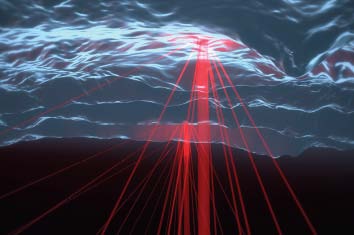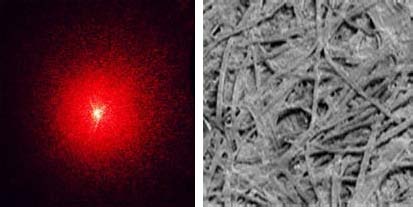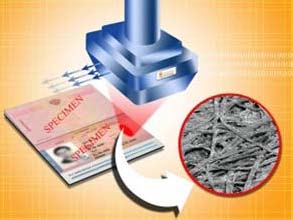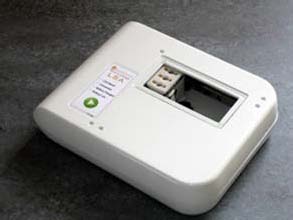Unique materials signature identified from nanotechnology research leads to spinout company to combat forgery (Ingenia)
Submitting Institution
University of DurhamUnit of Assessment
PhysicsSummary Impact Type
TechnologicalResearch Subject Area(s)
Chemical Sciences: Physical Chemistry (incl. Structural), Theoretical and Computational Chemistry
Engineering: Materials Engineering
Summary of the impact
Fundamental research in Durham Physics Department in 2002-4 demonstrated
that the nanoscale structure of materials gives a unique signature from
its effect on the diffuse scattering of laser light. Paper has a large
scale stochastic pattern from the wood fibres which is distinctive enough
to allow identification of the manufacturer, while small scale random
variations can uniquely identify an individual sheet. This technique can
be used to combat forgery by `fingerprinting' documents, packaging and
even gold bullion. The impact from this intellectual property is exploited
through a spinout company, Ingenia technology, which has won
multiple awards.
Underpinning research
The magnetism group in Durham Physics Department focuses on thin film
materials for spintronic devices. Such devices can provide a non-volatile
alternative to standard silicon memory chips, but the polarity of the
magnetic domains is difficult to switch reliably due to stochastic
fluctuations in the size of the domains. Russell Cowburn joined this group
as a lecturer in October 2000, and worked on characterising these
fluctuations in magnetic structures as a prerequisite to controlling them
[e.g. 1]. He used laser speckle imaging to determine the characteristic
size scale of the magnetic domains, where each point on the illuminated
surface acts as a secondary source of diffuse spherical waves which
interfere to produce a speckle pattern whose properties are determined by
the surface roughness over the entire illuminated surface (Fig 1). One day
the memory chip being tested fell off its paper backing, and the laser hit
the paper instead. Prof Cowburn realised that the speckle pattern (Fig 2)
that resulted from the paper fibres (Fig 3) had all the right
characteristics for a security device as it depended on the random, and
hence unique, alignment of nanoscale structures over the macroscopic size
of the sample.
 Fig 1: Surface roughness
giving rise to diffuse light
Fig 1: Surface roughness
giving rise to diffuse light
 Fig 2: Laser speckle pattern from surface roughness
Fig 2: Laser speckle pattern from surface roughness
Fig 3: Electron microscope
image of paper fibres
Cowburn's team at this time consisted of Atkinson (staff member in Durham
Physics 2001-present), Allwood (postdoc in Durham Physics 2001-2005, then
moving to Sheffield), Petit and Xiong (postdocs in Durham Physics
2001-2005, then moved to Imperial), Buchanan (PhD student and postdoc in
Durham 2000-2005, then moving to Imperial ), Jausovec (PhD student in
Durham 2003-2005, then moving to Imperial), and two undergraduate project
students, Kate Fenton (Durham MSci Physics 2001-2005), and Peter Seem
(summer student from Cornell BSc Engineering Physics 2001-2005). They were
able to show that the overall properties of the speckle pattern could be
used to identify the generic type of paper and its manufacturer, and that
the specific details of the speckle pattern were unique to each piece of
paper. An individual sheet of paper could be identified by its speckle pattern after being mixed back
into the full ream from which it was taken. This pattern is also very
stable as it depends solely on the topography of the fibres (Fig 3). This
meant that the paper could still be identified even after being charred
black by heat or soaked in water [2].
Cowburn's nanomagnetism research programme in Durham was supported to a
total of about £4M by Ingenia Holdings, a venture capital company then
operating under the name of Eastgate Investments Ltd. Initial patents
including both the process itself and technical aspects of pattern
matching via Fourier transforms were filed in March and August 2004 [P1-3]
and assigned to Ingenia Holdings under the terms of the research funding
agreement. In January 2005, Prof Cowburn moved to Imperial College, London
to take up a Chair in Nanotechnology, together with several of his
research group. The article describing the application of the technique to
the detection of forgery in documents and packaging appeared in Nature in
July 2005 [2]. Hence the majority of this underpinning research, described
in the paper, was performed in Durham, Prof Cowburn's Durham team
(including the undergraduate project students) being co-authors of the
paper.
References to the research
[2] Buchanan,
J.D.R., Cowburn, R.P., Jausovec, A-V, Petit, D., Seem, P., Xiong, G.,
Atkinson, D., Fenton, K., Allwood, D.A. and Bryan, M.T. 2005. Forgery:
`Fingerprinting' documents and packaging Nature 436: 475
(all authors were in Durham for the majority of their contribution to the
research) 78 citations
[P1] Cowburn, R.P. Determining
a signature from an article to determine its authenticity, UK
patent GB2411954B. Assignee Ingenia Technology, Application date 12th
March 2004, Publication date 14th September 2005
[P2] Cowburn R.P., Authenticity
verification methods, products and apparatuses, UK patent
GB2417074, Application date 13th August 2004, Publication date
15th February 2006
[P3] Cowburn R.P., Verification
of articles utilizing fourier transform thumbnails, UK patent
GB 2417592, Application date 13th August 2004, Publication date
1st March 2006
Details of the impact
A recent report from the UN's Office on Drugs and Crime (UNODC) on
organised crime across the Asia-Pacific region estimated that the market
in counterfeit goods is worth $24.4 billion i.e. about 2% of world trade,
and that it is as profitable for criminal gangs as the trade in illegal
drugs [C1]. This highlights the scale of the problem, and also the scale
of the potential impact of successfully combating forgery.
Ingenia Technology (UK) Ltd was incorporated in October 2006 to
commercialise the technique, now known as Laser Surface Authentification
(LSA). There followed much more research and development after Prof
Cowburn's move to Imperial College in order to turn the process into a
feasible, practical and robust technique to counter forgery and
counterfeiting, resulting in a whole series of subsequent patents which
cite the original work [e.g. P4-6].
LSA has major advantages over previous methods of authentication such as
watermarks or holograms in that the surface is an inherent rather than an
additional feature of the document so does not require additional
manufacturing. The speckle pattern depends on the nanoscale fluctuations
over the entire illuminated surface, and there is no known method to
fraudulently reproduce this, unlike watermarks/holograms which are
difficult but not impossible to replicate (if you can make it, you can
fake it). Ingenia Technology claims that it "has been described as
being like a fingerprint or DNA sequence for the item, is unique for
every document, card and carton and can be used to uniquely and
unambiguously identify the item." [C2]
Much of the business is in designing bespoke implementations, with
applications in security (Fig 4, from C2), customs, and law enforcement.
These are highly sensitive, so the company will not release details.
However, several applications are public, including authenticating
packaging of luxury goods and pharmaceutical products. The packaging is
scanned on the production line and the speckle pattern stored on a secure
custom database (LSANet). A mobile LSA field unit (Fig 5) can scan the
package anywhere in the world and authenticate it against the database
[C3]. This application was developed in partnership with Bayer Technology
Services GmbH, a subsidiary of Bayer GmbH which offers fully integrated
solutions for chemical/pharmaceutical plants [C4]. It is also used by
Cartondruck, a German based folding carton manufacturer, who installed an
LSA system on one of its production lines for packaging high-end perfumes,
cosmetics and other luxury products. Cartondruck Head of Sales and
Marketing says: "The LSA system is simple and 100% reliable, and it
works with different materials. Our customers don't have to come to us
or to send the product to us to have a scan made. We are happy to have
this market advantage." [C5]. The newest scanners, released in April
2013, are capable of processing 50 items per second, and the LSANet
database can now hold up to 100 billion items [C6].
 Fig 4: securities application of LSA technology
Fig 4: securities application of LSA technology
 Fig 5: LSA portable unit designed for use in
the field
Fig 5: LSA portable unit designed for use in
the field
The technology is not limited to paper but can be used on other systems
which exhibit stochastic fluctuations. Ingenia Technolgy has developed a
complete authentication system for precious metals with leading Swiss
refiner PAMP. This Veriscan™ system uses Ingenia's Laser Surface
Authentication system to scan and code every gold and silver bar produced
by PAMP and then enables authentication by multiple users across the
world. Ingenia hosts the secure database for PAMP and has developed a
customised version of their hardware and software for them [C7-8].
In 2010 Ingenia Technology signed a partnership agreement with IDT
Systems Ltd, a leading 2D and 3D in-surface decoration systems provider.
IDT will include LSA as part of its in-surface decoration and
personalisation offerings, specifically targeting the consumer electronics
sector. "Working with Ingenia Technology will allow us to offer a much
more comprehensive authentication and identification package for our
customers," commented the CEO of IDT Systems. "Ingenia's LSA
technology is the most robust and sophisticated solution for product
tracing and anti-counterfeiting that we have seen in the marketplace"
[C9].
Ingenia Technology (UK) Limited has its headquarters in London with
satellite offices in Vienna and Zurich. At 31st December 2011,
it had shareholder funds of just over £5M on its balance sheet [C10]. The
Ingenia team consists of 15 people, with a mix of business and security
experts. It includes three members who were originally part of the
university research team as well as specialist engineers and physicists
with many years of experience in electronic and product engineering [C11].
The company have won multiple awards including the prestigious 2006 Global
Security Challenge Award for the most promising Security Start-Up of the
year, with subsequent awards in 2007 from Hermes for Best Technology
(together with Bayer Technology Services), and two awards for Emerging
Technology Companies (Red Herring Europe 100 and Red Herring Global 100)
[C12].
Sources to corroborate the impact
[C1] UN report on transnational organised crime in East Asia and the
Pacific
http://www.unodc.org/documents/data-and-analysis/Studies/TOCTA_EAP_web.pdf
[C2] Ingenia web site securities application
http://www.ingeniatechnology.com/the-lsa-technology/
[C3] Ingenia web site — mobile field scanner
http://www.ingeniatechnology.com/product/
[C4] Ingenia presentation — Bayer Technology Services pharmaceutical
production line
http://www.who.int/impact/activities/McGlade.pdf
[C5] Packaging Today 2nd April 2012.
www.packagingtoday.co.uk/features/featurelooking-the-part
[C6] Ingenia high speed scanner launch
http://www.ingeniatechnology.com/wp-content/uploads/2013/04/ING130408_HighSpeedScannerLaunch.pdf
[C7] PAMP press release on Veriscan (not available on the web)
Filed with corroborating documents, also referenced in the PAMP news item
01/29/2013
http://www.pamp.ch/allnews
[C8] Andrew Gilbert, Business Development Director and Deputy Managing
Director of Ingenia Email filed with corroborating documents
[C9] Ingenia and IDT sign partnership agreement
http://www.businesswire.com/news/home/20101029005385/en/Ingenia-Technology-IDT-Systems-Sign-Partnership-Agreement
[C10] Ingenia accounts from FAME database
filed with corroborating documents
[C11] Ingenia about us
http://www.ingeniatechnology.com/about-us/
[C12] Wikipedia entry for Ingenia
http://en.wikipedia.org/wiki/Ingenia_Technology#Awards